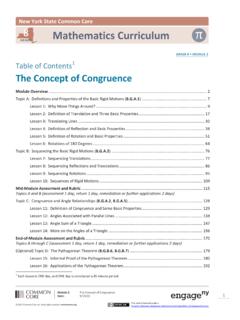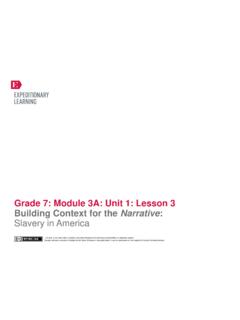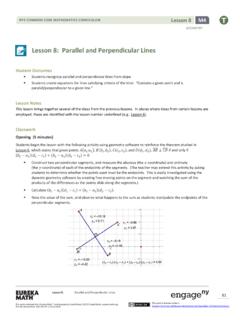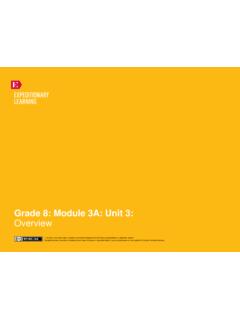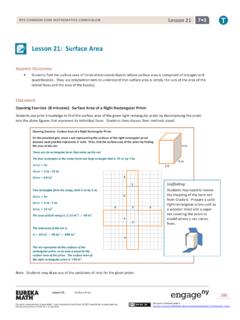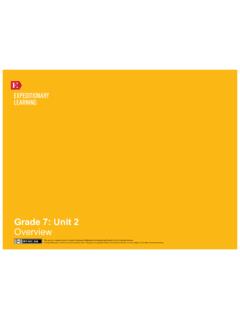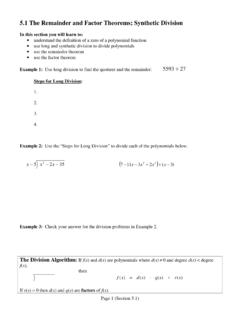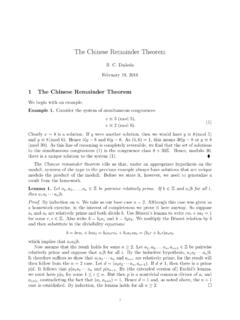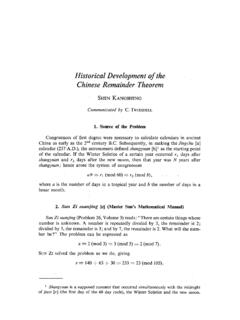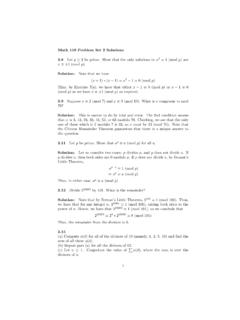Transcription of Lesson 19: The Remainder Theorem - EngageNY
1 NYS COMMON CORE MATHEMATICS CURRICULUM M1 Lesson 19 ALGEBRA II Lesson 19: The Remainder Theorem 206 This work is derived from Eureka Math and licensed by Great Minds. 2015 Great Minds. This file derived from ALG This work is licensed under a Creative Commons Attribution-NonCommercial-ShareAlike Unported License. Lesson 19: The Remainder Theorem Student Outcomes Students know and apply the Remainder Theorem and understand the role zeros play in the Theorem . Lesson Notes In this Lesson , students are primarily working on exercises that lead them to the concept of the Remainder Theorem , the connection between factors and zeros of a polynomial, and how this relates to the graph of a polynomial function.
2 Students should understand that for a polynomial function and a number , the Remainder on division by is the value ( ) and extend this to the idea that ( )=0 if and only if ( ) is a factor of the polynomial ( ). There should be plenty of discussion after each exercise. Classwork Exercises 1 3 (5 minutes) Assign different groups of students one of the three problems from this exercise. Have them complete their assigned problem, and then have a student from each group put their solution on the board.
3 Having the solutions readily available allows students to start looking for a pattern without making the Lesson too tedious. Exercises 1 3 1. Consider the polynomial function ( )= + . a. Divide by . b. Find ( ). ( ) = + =( + )+ ( ) = 2. Consider the polynomial function ( )= + + . a. Divide by + . b. Find ( ). ( ) + = + + + =( + ) + ( ) = ( )= 2 7 11 ( 8) 3 +1 ( 1)= 3 ( )=2 2+9 (2 +6)+272 2+9 (3)=27 Scaffolding: If students are struggling, replace the polynomials in Exercises 2 and 3 with easier polynomial functions.
4 Examples: a. Divide by +1. b. Find ( 1). a. Divide by 3. b. Find (3). NYS COMMON CORE MATHEMATICS CURRICULUM M1 Lesson 19 ALGEBRA II Lesson 19: The Remainder Theorem 207 This work is derived from Eureka Math and licensed by Great Minds. 2015 Great Minds. This file derived from ALG This work is licensed under a Creative Commons Attribution-NonCommercial-ShareAlike Unported License. 3. Consider the polynomial function ( )= + . a. Divide by . b.
5 Find ( ). ( ) = + =( + + )+ ( ) = Discussion (7 minutes) What is (2)? What is ( 1)? What is (3)? (2)=24; ( 1)= 2; (3)=30 Looking at the results of the quotient, what pattern do we see? The Remainder is the value of the function. Stating this in more general terms, what do we suspect about the connection between the Remainder from dividing a polynomial by and the value of ( )? The Remainder found after dividing by will be the same value as ( ).
6 Why would this be? Think about the quotient 133. We could write this as 13=4 3+1, where 4 is the quotient and 1 is the Remainder . Apply this same principle to Exercise 1. Write the following on the board, and talk through it: ( ) 2=3 2+8 4 2=(3 +14)+24 2 How can we rewrite using the equation above? Multiply both sides of the equation by 2 to get ( )=(3 +14)( 2)+24. In general we can say that if you divide polynomial by , then the Remainder must be a number; in fact, there is a (possibly non-zero degree) polynomial function such that the equation, ( ) = ( ) ( ) + quotient Remainder is true for all.
7 What is ( )? ( )= ( )( )+ = ( ) 0+ =0+ = We have just proven the Remainder Theorem , which is formally stated in the box below. Restate the Remainder Theorem in your own words to your partner. ( )= ( )( )+ ( ) Remainder Theorem : Let be a polynomial function in , and let be any real number. Then there exists a unique polynomial function such that the equation is true for all . That is, when a polynomial is divided by ( ), the Remainder is the value of the polynomial evaluated at.
8 NYS COMMON CORE MATHEMATICS CURRICULUM M1 Lesson 19 ALGEBRA II Lesson 19: The Remainder Theorem 208 This work is derived from Eureka Math and licensed by Great Minds. 2015 Great Minds. This file derived from ALG This work is licensed under a Creative Commons Attribution-NonCommercial-ShareAlike Unported License. Scaffolding: Challenge early finishers with this problem: Given that +1 and 1 are factors of ( )= 4+2 3 49 2 2 +48, write in factored form. Answer: ( +1)( 1)( +8)( 6) While students are doing this, circulate and informally assess student understanding before asking students to share their responses as a class.
9 Exercise 4 (5 minutes) Students may need more guidance through this exercise, but allow them to struggle with it first. After a few students have found , share various methods used. Exercise 4 6 4. Consider the polynomial ( )= + + + . a. Find the value of so that + is a factor of . In order for + to be a factor of , the Remainder must be zero. Hence, since + = ( ), we must have ( )= so that = + + . Then = . b. Find the other two factors of for the value of found in part (a).
10 ( )=( + )( + )=( + )( )( ) Discussion (7 minutes) Remember that for any polynomial function and real number , the Remainder Theorem says that there exists a polynomial so that ( )= ( )( )+ ( ). What does it mean if is a zero of a polynomial ? ( )=0 So what does the Remainder Theorem say if is a zero of ? There is a polynomial so that ( )= ( )( )+0. How does ( ) relate to if is a zero of ? If is a zero of , then ( ) is a factor of . How does the graph of a polynomial function = ( ) correspond to the equation of the polynomial ?
